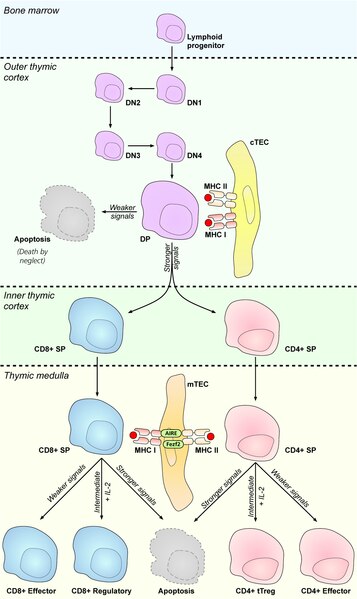File:Thymic selection.pdf
From Wikimedia Commons, the free media repository
Jump to navigation
Jump to search

Size of this JPG preview of this PDF file: 357 × 599 pixels. Other resolutions: 143 × 240 pixels | 286 × 480 pixels | 458 × 768 pixels | 610 × 1,024 pixels | 1,221 × 2,048 pixels | 4,795 × 8,043 pixels.
Original file (4,795 × 8,043 pixels, file size: 104 KB, MIME type: application/pdf)
File information
Structured data
Captions
Captions
A figure depicting the process of T cell / thymocyte positive and negative selection in the thymus
Summary
[edit]| DescriptionThymic selection.pdf |
English: A figure depicting the process of T cell / thymocyte positive and negative selection in the thymus
Figure legend Lymphoid progenitors migrate from the bone marrow to the thymic cortex. Here they develop through a number of intermediate stages termed double-negative (DN) 1 to 4 where the cells remain negative for both the CD4 and CD8 co-receptors. During this process, the cells lose expression of CD44 and transiently express the IL2 receptor. There is rearrangement of the T cell receptor beta chain, and then if the beta chain successfully pairs with the pre-alpha chain, the alpha chain is rearranged, the cells proliferate and then enter a double-positive (DP) stage expressing the TCR, CD4 and CD8. Here, if the cells receive adequate signals through their TCR in response to antigenic sequences expressed by cortical thymic epithelial cells, they survive and are polarised towards persistent expression of either CD4 or CD8 depending on their specificity. If cells do not receive sufficient stimulation, they enter apoptosis: so-called death by neglect. Next, single-positive (SP) cells enter the thymic medulla and interact with self-antigens expressed on medullary thymic epithelial cells. The expression of otherwise tissue-restricted self antigens is mediated by AIRE and Fezf2. Cells that receive weaker signals adopt an effector phenotype, cells that receive intermediate signals adopt a regulatory phenotype whilst cells that receive strong signals from self antigen enter apoptosis |
| Date | |
| Source | Own work |
| Author | Gwilz |
Licensing
[edit]I, the copyright holder of this work, hereby publish it under the following license:
This file is licensed under the Creative Commons Attribution-Share Alike 4.0 International license.
- You are free:
- to share – to copy, distribute and transmit the work
- to remix – to adapt the work
- Under the following conditions:
- attribution – You must give appropriate credit, provide a link to the license, and indicate if changes were made. You may do so in any reasonable manner, but not in any way that suggests the licensor endorses you or your use.
- share alike – If you remix, transform, or build upon the material, you must distribute your contributions under the same or compatible license as the original.
File history
Click on a date/time to view the file as it appeared at that time.
| Date/Time | Thumbnail | Dimensions | User | Comment | |
|---|---|---|---|---|---|
| current | 17:01, 14 February 2019 |  | 4,795 × 8,043 (104 KB) | Gwilz (talk | contribs) | User created page with UploadWizard |
You cannot overwrite this file.
File usage on Commons
There are no pages that use this file.
File usage on other wikis
The following other wikis use this file:
- Usage on en.wikipedia.org
- Usage on gl.wikipedia.org
- Usage on he.wikipedia.org
- Usage on hi.wikipedia.org
Metadata
This file contains additional information such as Exif metadata which may have been added by the digital camera, scanner, or software program used to create or digitize it. If the file has been modified from its original state, some details such as the timestamp may not fully reflect those of the original file. The timestamp is only as accurate as the clock in the camera, and it may be completely wrong.
| Conversion program | Mac OS X 10.10.5 Quartz PDFContext |
|---|---|
| Encrypted | no |
| Page size | 2302 x 3861 pts |
| Version of PDF format | 1.3 |